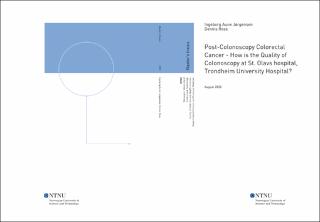| dc.description.abstract | Bakgrunn
Koloskopi regnes som gullstandard ved diagnostikk av kolorektal cancer (CRC). Lesjoner kan imidlertid oversees og utvikle seg til post-koloskopi kolorektal cancer (PCCRC). PCCRC har de siste årene fått økende anerkjennelse som et viktig mål på koloskopikvalitet. Formålet med denne studien var å undersøke kvaliteten på koloskopier utført ved St. Olavs hospital, Universitetssykehuset i Trondheim, ved å beregne andelen PCCRC-tilfeller og utforske assosierte karakteristika ved disse tumorene, pasientene og koloskopiene.
Metode
Vi gjennomførte en retrospektiv kvalitetsvurdering av 17 670 koloskopier utført mellom 2010 og 2014 ved St. Olavs hospital, Universitetssykehuset i Trondheim, og registrerte andelen PCCRC-tilfeller utviklet innen 5 år etter indekskoloskopier uten funn av tumores. Kun PCCRC-tilfeller med histologisk verifisert adenokarsinom ble inkludert. Videre kalkulerte vi andelen av CRC diagnostisert i 2013 og 2014 som var PCCRC-tilfeller utviklet innen 3 år etter indekskoloskopier. For å karakterisere PCCRC-pasientene registrerte vi variabler vedrørende tumorene, pasientene og koloskopiene.
Resultat
Av totalt 17 670 koloskopier ble 74 (0.42%) PCCRC-tilfeller registrert. Adenom deteksjonsrate (ADR) var 39.2% ved indekskoloskopiene utført i forkant av PCCRC-tilfellene. Av alle PCCRC-tilfeller var 47 (63.5%) proksimale cancere (høyre colon eller colon transversum) og 42 (56.8%) var lokaliserte cancere (stadium I eller II) ved diagnosetidspunktet. Når det gjelder kjønnsfordeling oppstod 48 (64.9%) PCCRC-tilfeller hos kvinner og 26 (35.1%) hos menn. Videre hadde 24.3% en førstegradsslektning med CRC og 8.1% hadde inflammatorisk tarmsykdom (IBD). Pasienter som hadde planlagt endoskopisk oppfølging ved tidspunktet for cancerdiagnosen var signifikant yngre ved cancerdiagnose (71.4 vs 76.1 år, p = 0.022) og hadde en signifikant mindre tumorstørrelse (24.2 vs 42.0 mm, p <0.001) sammenlignet med dem uten endoskopisk oppfølging. I 2013 og 2014 utgjorde PCCRC-tilfeller oppstått innen 3 år etter indekskoloskopi omtrent 4% av alle diagnostiserte CRC.
Konklusjon
I denne studien har vi undersøkt andelen PCCRC oppstått etter koloskopier utført ved St. Olavs hospital, Universitetssykehuset i Trondheim, i perioden 2010 til 2014. PCCRC regnes som et viktig mål på koloskopikvalitet, og våre funn er representative for den totale kvaliteten på alle koloskopier utført ved sykehuset. Proksimal cancerlokalisasjon, tidlig stadium, kvinnelig kjønn, IBD og en familiehistorie med CRC er alle faktorer som ser ut til å være assosiert med PCCRC. Disse funnene kan hjelpe endoskopører med å identifisere individer med økt risiko for oversette lesjoner. Grundig undersøkelse av proksimale tykktarm, samt en grundig anamnese vedrørende førstegradsslektninger med CRC kan være spesielt viktig. | |
| dc.description.abstract | Background and aims
Colonoscopy is considered the gold standard in diagnosing colorectal cancer (CRC). However, lesions can be missed and give rise to post-colonoscopy colorectal cancers (PCCRCs), which in recent years have been increasingly recognized as an important measure of colonoscopy quality. The aim of this study was to investigate the quality of colonoscopies performed at St. Olavs hospital, Trondheim University Hospital, by calculating the proportion of PCCRC cases, and examine associated characteristics of these patients, colonoscopies and tumors.
Methods
We conducted a retrospective quality assessment of 17 670 colonoscopies performed over the period of 2010 to 2014 at St. Olavs hospital, Trondheim University Hospital, and registered the proportion of PCCRCs developed within 5 years after an index colonoscopy without detected tumors. Only PCCRCs with histologically verified adenocarcinoma were included. Furthermore, we calculated the proportion of CRCs diagnosed in 2013 and 2014 that were PCCRCs developed within 3 years after an index colonoscopy. To characterize the PCCRC patients, we registered data regarding the patients, index colonoscopies and tumors.
Results
In a total of 17 670 colonoscopies, 74 (0.42%) PCCRC cases were identified. Adenoma detection rate (ADR) was 39.2% at the index colonoscopies prior to the PCCRCs. Forty-seven (63.5%) PCCRCs were proximal cancers (right or transverse colon). Concerning staging, 42 (56.8%) cancers were localized (stage I or II). Among the PCCRCs, 48 (64.9%) occurred in women and 26 (35.1%) in men. Furthermore, 24.3% had a first degree relative with CRC and 8.1% had a previous history of inflammatory bowel disease (IBD). Patients in an endoscopic follow-up program at the time of cancer diagnosis had a significantly lower mean age at cancer diagnosis (71.4 vs 76.1 years, p = 0.022) and the mean tumor size was smaller (24.2 vs 42.0 mm, p <0.001) compared to those who were not. In 2013 and 2014, approximately 4% of diagnosed CRCs were PCCRCs occurred within 3 years after an index colonoscopy.
Conclusions
This study provides an important measure of colonoscopy quality, that is, cancer after a colonoscopy in which no cancer was found. Our findings are representative for the total quality of all colonoscopies performed at St. Olavs hospital, Trondheim University Hospital, over the period of 2010 to 2014. Proximal location, early stage, female gender, IBD and a family history of CRC are all factors that seem to be associated with PCCRC. These characteristics may help endoscopists to identify patients with increased risk of missed lesions. Thorough examination of the proximal colon and a proper anamnesis regarding family history may be of special importance. | |
